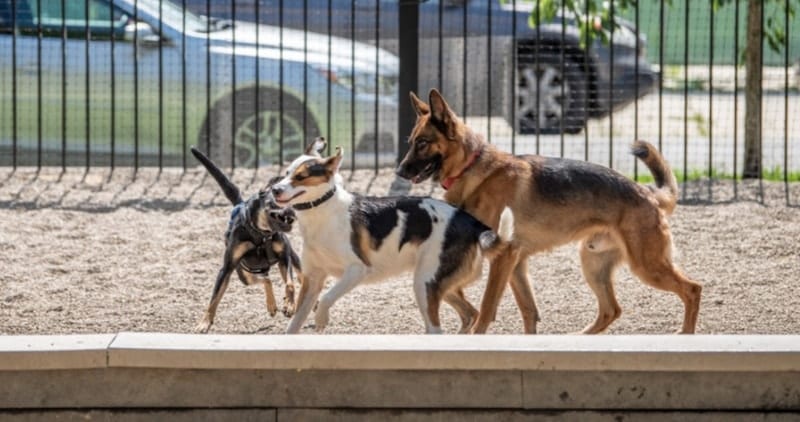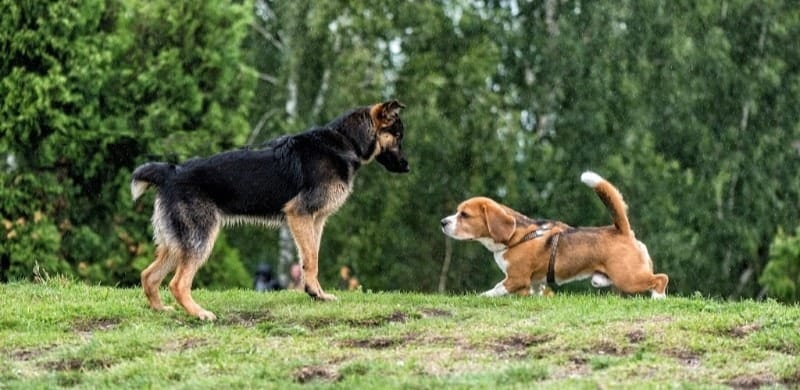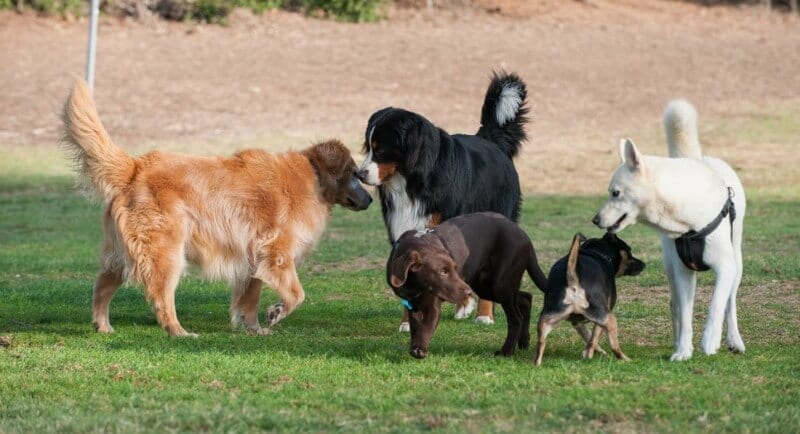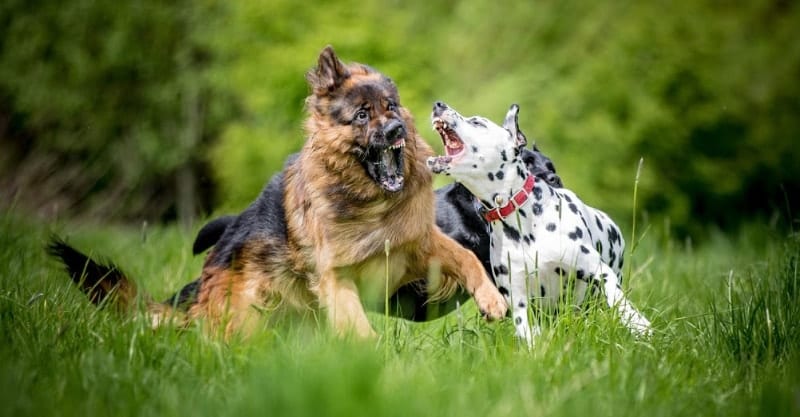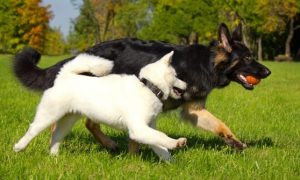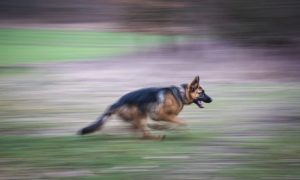What Purpose Do Dog Parks Serve?
The general idea behind dog parks is that they are a place where dog owners with little space at home can go to get the dogs the exercise and play that they need.
It would appear to be the ideal spot for those who live in the heart of the city or an apartment complex.
Another common notion is that dog parks are a place where dogs can go to socialize, and it is there where the biggest issue tends to come to light.
Dog Parks and their Inherent Dangers
It is worth noting that the basic premise of dog parks is one that is well-intended, but it doesn’t work so well in an off-leash setting.
It is not the fault of the dogs, but rather the owners who do not know the pack culture of dogs. That essentially boils down to well-behaved dogs being allowed to get out of control.
Very few owners take the time to learn about how the pack structure with dogs works.
Pack instinct is foreign to the average owner, but it is something that is built into the DNA of every dog. That instinct goes to the next level at the dog park.
There will be dogs that go to the park every day, and it is those dogs that are likely to look at a new dog as being one that is essentially invading their territory.
They don’t view this new dog as a buddy, but rather as an enemy who may have to be dealt with aggressively.
The Formation of Packs in the Park
It only takes three or more dogs to form a pack, which is not that difficult at the dog park.
They will essentially become a pack without a leader, which is what the human role should be. That leads them to build a pecking order within the group, which is where many of the problems start to take shape.
The result of this need for a rank is that the dogs will take to fighting one another.
You make a critical mistake as an owner by merely assuming that every dog in the park will be as well trained and obedient as yours.
Seeing a dog that plays well with others is not a sign that they will play with yours in the same way.
Dogs that are playing together may have already settled on rank, which means the introduction of your dog to the group upsets that apple cart.
Your pet will be blissfully unaware of the pack rules in place which could lead to problems. Your dog may fight the leader, causing the rest of the pack to jump in and help their pack buddy.
People will complain their dog is continuously shying away from other dogs they encounter when on walks. These people have no idea how pack structure works.
Most dogs are not interested in becoming pack leaders and are happy to allow you, the owner, to adopt that role.
What that means is they will look to you to protect them.
When a dog feels threatened, there is a reason they run back to you, and that is because they view you as the pack leader. They will quickly lose confidence in you if you do not deliver that protection.
Failure to notice your dog feels threatened could lead to them adopting a fight or flight mentality.
Try to think of the behavior of your dog in another way. Would you expect your children to go toe to toe with adult intruders in your home?
Of course not, yet there any may owners that believe their dogs should do just that when face to face with older dogs, bigger dogs, or aggressive dogs.
Again, this is caused by a lack of understanding pack culture and dog training.
There are false assumptions by many, for example, that a dog with working bloodlines means they will be naturally strong and tough. A dog may genetically be inclined to be strong and tough but environment, socialization, and training are important factors.
Owners that adopt the role of the pack leader from the very moment they bring a new dog or puppy into the home will be more likely to end up with a confident adult dog.
Those that don’t will end up with an animal that is either overly aggressive or scared of its own shadow.
There is no way a breeder can guarantee the temperament of a dog, as it can be significantly affected by the role that the owner takes when raising the dog.
Proper Handling Skills in the Dog Park
If you see a dog aggressively heading towards yours, it is up to you to take charge of the situation.
The main sign of potential aggressive behavior in a dog will be a stiff body and legs.
Their tail will be either pointing straight up or straight back and never tucked in a submissive posture.
The reason dogs take on this stance is to make them appear larger than they are.
Watch out for dogs that TEE OFF on yours. They do this by placing their muzzle across the shoulders of your dog in a display of dominance.
You need to:
- Let the owner of the other dog know that they need to get control of their animal.
- If you have no luck doing that, it is your cue to leave the park. Any aggression towards your dog should be reported to the police, making them aware that you were also concerned about your safety.
- If the situation has already passed the point of no return, use a deep voice to let the other dog know in no uncertain terms that it is time for them to leave. Often this is enough to make the aggressive dog back off. Even if this works, you have to assess the situation and decide whether or not the threat is completely gone. Safety should be your priority.
- Do not resort to taking weapons like sticks and pepper spray to the dog park. If you don’t know how to break up a dogfight in the proper manner, it is best to avoid the park until it’s a skill you do learn.
- There are situations in dog parks when strays find their way inside and become aggressive. A verbal warning may not work. A walking cane or pepper spray might be needed to prevent your dog from getting hurt. Hitting the stray dog hard between the ears will often get him to back off in these situations. Taking action is not something that every owner will be comfortable doing, but everyone can make a call to the proper authorities to let them know there is a stray dog in the park that doesn’t belong there.
Some breeds will be more likely to fight than others, but every breed has a bully in the bunch.
Too many irresponsible owners are looking at these fighting breeds as being the ideal pet. When they then fail to train them properly but still insist on taking them to the dog park, you end up with a recipe for disaster.
Another thing to be aware of is that puppies and dogs that have been attacked by another dog can develop an aggressive streak of their own.
A single, solitary attack is sometimes enough to change the temperament of a once demure dog permanently. Owners quickly discover that looking after an aggressive dog is a real challenge.
If you notice that your dog is one of the aggressive bullies, it is up to you, the pack leader, to let him know the behavior is unacceptable.
Some dogs will get the message via verbal reprimands, while others will need a more severe correction strategy.
Some of the latter include prong collars or a remote collar, which is something that should only be used after proper training.
Dogs that are aggressive need these forms of correction, so they learn and understand that consequences come with aggressive behavior.
As an owner, it’s vital to deliver a timely correction that is swift and meaningful when you see your dog is about to engage in unwanted aggressive behavior.
Once your dog understands aggressive behavior will not be tolerated, they will become better-behaved and more manageable.
If you are unable to give a proper correction on a prong collar due to physical limitations, size, or strength, such as a small woman with a large German Shepherd, control can be accomplished with a remote collar.
An owner that is not able to assume the dominant role with their dog should refrain from visiting the dog park until they do.
If you cannot adequately control your dog at home, how can you expect to do it at a park where a bunch of other dogs with similar problems are hanging out?

